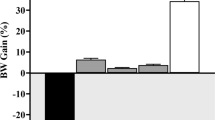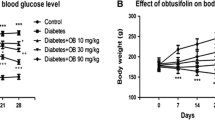Abstract
The present study was undertaken to investigate the hepatoprotective effect of Momordica charantia in alloxan induced diabetic rats. The experimental rats were randomly divided into four groups. Oral glucose tolerance test (OGTT) and biochemical analysis for oxidative stress parameters and liver function marker enzymes were analyzed for each group of rats. Moreover, histological staining was also performed on liver sections. Momordica charantia supplementation prevented the rise of blood glucose level and improved oral glucose tolerance test in alloxan induced diabetic rats. Liver marker enzymes such as aspartate transaminase (AST), alanine transaminase (ALT), alkaline phosphatase (ALP) activities were increased in alloxan induced rats which were normalized in Momordica charantia supplemented group. In addition, elevated level of oxidative stress markers were also observed in alloxan induced diabetic rats. Momordica charantia supplementation significantly restored the superoxide dismutase (SOD), catalase (CAT) enzymes activities and increased reduced glutathione (GSH) concentration in diabetic rats. Histological assessments confirm the mononuclear cell infiltration and fibrosis in liver of alloxan induced diabetic rats which were ameliorated by Momordica charantia supplementation. The present investigation suggests the hepatoprotective nature of Momordica charantia in diabetic rats probably by attenuating oxidative stress and improving the antioxidant competence in hepatic tissues.






Similar content being viewed by others
References
Ahad A, Ganai AA, Mujeeb M, Siddiqui WA (2014) Ellagic acid, an NF-kappaB inhibitor, ameliorates renal function in experimental diabetic nephropathy. Chem Biol Interact 219:64–75. doi:10.1016/j.cbi.2014.05.011
Ahmed I, Adeghate E, Cummings E, Sharma AK, Singh J (2004) Beneficial effects and mechanism of action of Momordica charantia juice in the treatment of streptozotocin-induced diabetes mellitus in rat. Mol Cell Biochem 261:63–70
Alam M, Uddin R, Subhan N, Rahman M, Jain P, Reza H (2015) Beneficial role of Bitter melon supplementation on obesity and related complications in metabolic syndrome Journal of lipids in press
Albright ES, Bell DSH (2003) The liver, liver disease, and diabetes mellitus. Endocrinologist 13:58–66
American Diabetes A (2013) Diagnosis and classification of diabetes mellitus. Diabetes Care 36(Suppl 1):S67–S74. doi:10.2337/dc13-S067
American Diabetes A (2014) Diagnosis and classification of diabetes mellitus. Diabetes Care 37(Suppl 1):S81–S90. doi:10.2337/dc14-S081
Balasubramanian T, Senthilkumar GP, Karthikeyan M, Chatterjee TK (2013) Protective effect of ethyl acetate fraction of Stereospermum suaveolens against hepatic oxidative stress in STZ diabetic rats. J Tradition Complement Med 3:175–181. doi:10.4103/2225-4110.114904
Bataller R, Brenner DA (2005) Liver fibrosis. J Clin Invest 115:209–218. doi:10.1172/JCI24282
Baxter LC, Schofield PJ (1980) The effects of a high fat diet on chronic streptozotocin-diabetic rats. Diabetologia 18:239–254
Beckman JA, Goldfine AB, Gordon MB, Garrett LA, Keaney JF Jr, Creager MA (2003) Oral antioxidant therapy improves endothelial function in Type 1 but not Type 2 diabetes mellitus. Am J Phys Heart Circ Phys 285:H2392–H2398. doi:10.1152/ajpheart.00403.2003
Bradley PP, Priebat DA, Christensen RD, Rothstein G (1982) Measurement of cutaneous inflammation: estimation of neutrophil content with an enzyme marker. J Investig Dermatol 78:206–209
Chance B, Maehly A (1955) Assay of catalase and peroxidases. Methods Enzymol 11:764–775
Chaudhari B, Chaware V, Joshi Y, Biyani K (2009) Hepatoprotective activity of Hydroalcoholic extract of Momordica charantia Linn. Leaves against carbon tetra chloride induced Hepatopathy in rats. Int J ChemTech Res 1:355–358
Cummings E, Hundal HS, Wackerhage H, Hope M, Belle M, Adeghate E, Singh J (2004) Momordica charantia Fruit juice stimulates glucose and amino acid uptakes in L6 myotubes. Mol Cell Biochem 261:99–104
Degirmenci I, Kalender S, Ustuner MC, Kalender Y, Gunes HV, Unal N, Basaran A (2002) The effects of acarbose and Rumex patientia on liver ultrastructure in streptozotocin-induced diabetic (type II) rats. Drugs Exp Clin Res 28:229–234
Elpek GÖ (2014) Cellular and molecular mechanisms in the pathogenesis of liver fibrosis: An update. World J of Gastroenterol : WJG 20:7260–7276. doi:10.3748/wjg.v20.i23.7260
Fan W, Liu A, Wang W, Zheng G, Teng A (2012) Hepatoprotective activity of CrPic against alloxan-induced hepatotoxicity in mice. Biol Trace Elem Res 149:227–233. doi:10.1007/s12011-012-9415-8
Gadang V, Gilbert W, Hettiararchchy N, Horax R, Katwa L, Devareddy L (2011) Dietary bitter melon seed increases peroxisome proliferator-activated receptor-gamma gene expression in adipose tissue, down-regulates the nuclear factor-kappaB expression, and alleviates the symptoms associated with metabolic syndrome. J Med Food 14:86–93. doi:10.1089/jmf.2010.0010
Ghani A (2003) Medicinal plants of Bangladesh with chemical constituents and uses vol, 2nd edn. Asiatic Society of Bangladesh, Dhaka
Hamden K, Ayadi F, Jamoussi K, Masmoudi H, Elfeki A (2008) Therapeutic effect of phytoecdysteroids rich extract from Ajuga Iva on alloxan induced diabetic rats liver, kidney and pancreas. Biofactors 33:165–175
Jahan I, Akbar P, Khan N, Khan T, Rahman M, Arpona H, Hossain H (2014) Comparative study of anti-nociceptive activity and phenolic content of the ethanol extracts of Piper nigrum and Piper longum fruits. Int J Pharm Sci Rev Res 27:47–52
Jayasooriya AP, Sakono M, Yukizaki C, Kawano M, Yamamoto K, Fukuda N (2000) Effects of Momordica charantia powder on serum glucose levels and various lipid parameters in rats fed with cholesterol-free and cholesterol-enriched diets. J Ethnopharmacol 72:331–336
Jollow D, Mitchell J, Zampaglione N, Gillette J (1974) Bromobenzene-induced liver necrosis. Protective role of glutathione and evidence for 3,4-bromobenzene oxide as the hepatotoxic metabolite. Pharmacology 11:151–169
Kandasamy N, Ashokkumar N (2014) Protective effect of bioflavonoid myricetin enhances carbohydrate metabolic enzymes and insulin signaling molecules in streptozotocin-cadmium induced diabetic nephrotoxic rats. Toxicol Appl Pharmacol 279:173–185. doi:10.1016/j.taap.2014.05.014
Khan R (2012) Protective effects of Sonchus asper (L.) hill, (Asteraceae) against CCl4-induced oxidative stress in the thyroid tissue of rats. BMC Complement Altern Med 12:181
Lam DW, LeRoith D (2012) The worldwide diabetes epidemic current opinion in endocrinology, diabetes and. Obesity 19:93–96. doi:10.1097/MED.1090b1013e328350583a
Lenzen S (2008) The mechanisms of alloxan- and streptozotocin-induced diabetes. Diabetologia 51:216–226. doi:10.1007/s00125-007-0886-7
Mahomoodally MF, Gurib-Fakim A, Subratty AH (2007) Effect of exogenous ATP on Momordica charantia Linn. (Cucurbitaceae) induced inhibition of D-glucose, L-tyrosine and fluid transport across rat everted intestinal sacs in vitro. J Ethnopharmacol 110:257–263. doi:10.1016/j.jep.2006.09.020
Mansouri E, Khorsandi L, Abedi HA (2014) Antioxidant effects of proanthocyanidin from grape seed on hepatic tissue injury in diabetic rats Iranian. J Basic Med Sci 17:460–464
Mekinova D, Chorvathova V, Volkovova K, Staruchova M, Grancicova E, Klvanova J, Ondreicka R (1995) Effect of intake of exogenous vitamins C, E and beta-carotene on the antioxidative status in kidneys of rats with streptozotocin-induced diabetes. Die Nahrung 39:257–261
Mir SH, Darzi MM (2009) Histopathological abnormalities of prolonged alloxan-induced diabetes mellitus in rabbits. Int J Exp Pathol 90:66–73. doi:10.1111/j.1365-2613.2008.00615.x
Misra HP, Fridovich I (1972) The role of superoxide anion in the autoxidation of epinephrine and a simple assay for superoxide dismutase. J Biol Chem 247:3170–3175
Nerurkar P, Lee Y-K, Nerurkar V (2010) Momordica charantia (bitter melon) inhibits primary human adipocyte differentiation by modulating adipogenic genes. BMC Complement Altern Med 10:34
Niehaus WG, Samuelsson B (1968) Formation of malonaldehyde from phospholipid arachidonate during microsomal lipid peroxidation European. J Biochem 6:126–130. doi:10.1111/j.1432-1033.1968.tb00428.x
Okita K, Sakaida I, Hino K (2002) Current strategies for chemoprevention of hepatocellular carcinoma. Oncology 62(Suppl 1):24–28
Ong KC, Khoo HE (2000) Effects of myricetin on glycemia and glycogen metabolism in diabetic rats. Life Sci 67:1695–1705
Panchal SK, Ward L, Brown L (2013) Ellagic acid attenuates high-carbohydrate, high-fat diet-induced metabolic syndrome in rats. Eur J Nutr 52:559–568. doi:10.1007/s00394-012-0358-9
Panneerselvam SR, Govindasamy S (2004) Effect of sodium molybdate on the status of lipids, lipid peroxidation and antioxidant systems in alloxan-induced diabetic rats. Clin Chim Acta; Int J Clin Chem 345:93–98. doi:10.1016/j.cccn.2004.03.005
Rauscher FM, Sanders RA, Watkins JB, 3rd (2001) Effects of coenzyme Q10 treatment on antioxidant pathways in normal and streptozotocin-induced diabetic rats. J Biochem Mol Toxicol 15:41–46
Rockey DC (2008) Current and future anti-fibrotic therapies for chronic liver disease Clin Liver Dis 12:939–962, xi doi:10.1016/j.cld.2008.07.011
Sagor AT, Chowdhury MR, Tabassum N, Hossain H, Rahman MM, Alam MA (2015) Supplementation of fresh ucche (Momordica charantia L. Var. Muricata Willd) prevented oxidative stress, fibrosis and hepatic damage in CCl4 treated rats. BMC Complement Altern Med 15:115. doi:10.1186/s12906-015-0636-1
Saleem Mir M, Maqbool Darzi M, Musadiq Khan H, Ahmad Kamil S, Hassan Sofi A, Ahmad Wani S (2013) Pathomorphological effects of aAlloxan induced acute hypoglycaemia in rabbits Alexandria. J Med 49:343–353. doi:10.1016/j.ajme.2013.03.007
Sathishsekar D, Subramanian S (2005) Beneficial effects of Momordica charantia seeds in the treatment of STZ-induced diabetes in experimental rats. Biol Pharm Bull 28:978–983
Shibib BA, Khan LA, Rahman R (1993) Hypoglycaemic activity of Coccinia indica and Momordica charantia in diabetic rats: depression of the hepatic gluconeogenic enzymes glucose-6-phosphatase and fructose-1,6-bisphosphatase and elevation of both liver and red-cell shunt enzyme glucose-6-phosphate dehydrogenase. Biochem J 292(Pt 1):267–270
Shih CC, Lin CH, Lin WL, JB W (2009) Momordica charantia Extract on insulin resistance and the skeletal muscle GLUT4 protein in fructose-fed rats. J Ethnopharmacol 123:82–90. doi:10.1016/j.jep.2009.02.039
Singh N, Gupta M (2007) Regeneration of beta cells in islets of Langerhans of pancreas of alloxan diabetic rats by acetone extract of Momordica charantia (Linn.) (bitter gourd) fruits. Indian J Exp Biol 45:1055–1062
Singh N, Gupta M, Sirohi P, Varsha (2008) Effects of alcoholic extract of Momordica charantia (Linn.) whole fruit powder on the pancreatic islets of alloxan diabetic albino rats Journal of environmental biology. Acad Environ Biol India 29:101–106
Tan MJ et al (2008) Antidiabetic activities of triterpenoids isolated from bitter melon associated with activation of the AMPK pathway. Chem Biol 15:263–273. doi:10.1016/j.chembiol.2008.01.013
Tennekoon KH, Jeevathayaparan S, Angunawala P, Karunanayake EH, Jayasinghe KS (1994) Effect of Momordica charantia on key hepatic enzymes. J Ethnopharmacol 44:93–97
Tiwari BK, Kumar D, Abidi AB, Rizvi SI (2014) Efficacy of Composite Extract from Leaves and Fruits of Medicinal Plants Used in Traditional Diabetic Therapy against Oxidative Stress in Alloxan-Induced Diabetic Rats. ISRN Pharmacol 2014:7. doi:10.1155/2014/608590
Tracey WR, Tse J, Carter G (1995) Lipopolysaccharide-induced changes in plasma nitrite and nitrate concentrations in rats and mice: pharmacological evaluation of nitric oxide synthase inhibitors. J Pharmacol Exp Ther 272:1011–1015
Uebanso T et al (2007) Extracts of Momordica charantia suppress postprandial hyperglycemia in rats. J Nutr Sci Vitaminol (Tokyo) 53:482–488
Virdi J, Sivakami S, Shahani S, Suthar AC, Banavalikar MM, Biyani MK (2003) Antihyperglycemic effects of three extracts from Momordica charantia. J Ethnopharmacol 88:107–111
Wagner K-H, Brath H (2012) A global view on the development of non communicable diseases. Prev Med 54(Supplement):S38–S41. doi:10.1016/j.ypmed.2011.11.012
Witko-Sarsat V et al (1996) Advanced oxidation protein products as a novel marker of oxidative stress in uremia. Kidney Int 49:1304–1313
Wlazlo N, Beijers, HJ, Schoon, EJ, Sauerwein, HP, Stehouwer, CD, Bravenboer, B (2010) High prevalence of diabetes mellitus in patients with liver cirrhosis. Diabet Med 27:1308–1311
Zahra K, Malik MA, Mughal MS, Arshad M, Sohai MI (2012) Hepatoprotective role of extracts of Mmomordica charantia L in acetaminophen-induced toxicity in rabbits. J Anim Plant Sci 22:273–277
Acknowledgments
This research received no specific grant from any funding agency in the public, commercial, or not-for-profit sectors. Research was conducted in Department of Pharmaceutical Sciences, North South University, Bangladesh. The authors are thankful to the authority of Department of Pharmaceutical Sciences, North South University, Bangladesh for the providing facilities for present work.
Author information
Authors and Affiliations
Corresponding author
Ethics declarations
Ethical statements
Prior permission for animal use and approval of the protocol were obtained from the Institutional Animal Ethical Committee (Ethical Committee, North South University, Bangladesh).
Conflict of Interests
The authors declared no potential conflict of interests with respect to the research, authorship, and/or publication of this paper.
Rights and permissions
About this article
Cite this article
Arafat, S.Y., Nayeem, M., Jahan, S. et al. Ellagic acid rich Momordica charantia fruit pulp supplementation prevented oxidative stress, fibrosis and inflammation in liver of alloxan induced diabetic rats. Orient Pharm Exp Med 16, 267–278 (2016). https://doi.org/10.1007/s13596-016-0242-x
Received:
Accepted:
Published:
Issue Date:
DOI: https://doi.org/10.1007/s13596-016-0242-x




